Gwalior gharana
The Gwalior Gharana is one of the oldest Khyal Gharanas. The rise of the Gwalior Gharana started with the reign of the great Mughal emperor Akbar (1542–1605). The favorite singers of this patron of the arts, such as Miyan Tansen, first amongst the vocalists at the court, came from the town of Gwalior.
History
During the time of Mughal kings Ustad Naththan Pir Bakhsh and his maternal grandsons were the legendary Haddu, Hassu and Natthu Khan.[1] The main musician in the court at the time was Ustad Bade Mohammad Khan who was famous for his taanbaazi. Both Ustad Bade Mohammad Khan and Ustad Naththan Pir Bakhsh belonged to the same tradition of Shahi Sadarang.
Some sources believe that Ustad Naththan Pir Bakhsh settled in Gwalior and evolved the style features that led to this gharana. Others claim that individuals named Naththan Pir Bakhsh and Nathu Khan founded the gharana. The accepted version is that Naththan Pir Baksh left Lucknow in Uttar Pradesh to escape the professional rivalry with Ustad Shakkar Khan that had taken an ugly turn. He arrived in Gwalior with his maternal grandsons Haddu Khan and Hassu Khan.
Another great khayal singer, also originally from Lucknow, was Ustad Bade Mohammed Khan who brought the Taan into khayal singing. Haddu Khan and Hassu Khan further enhanced the style of the Gwalior gharana as we recognize it today. Hassu Khan died prematurely. Haddu Khan's son, Rehmat Ali Khan (1852–1922) was a widely acclaimed singer who liberated the Gwalior style from the methodical form it followed to the emotional style that he preferred.
Singing style
A distinguishing feature of the gharana is its simplicity, and one means to this is the selection of well-known ragas so that the listener is saved the effort of trying to identify the raga. While the khyal singer does include "Raga Vistar" (melodic expansion) and "Alankar" (melodic ornamentation) to enhance the beauty and meaning of the raga, there is no attempt to include the "Tirobhava" (using melodic phrases to obscure the identity of the raga) feature in the interest of adding interest or mystery to the listener's experience.
The singing itself places Bandish (the composition) at the heart of the presentation because of the gharana's belief that the full melody of the raga and guidance on its singing is provided by the bandish. The asthayi section is sung twice before the antara, to be followed by swar-vistar in medium tempo. This slow rendition of the notes is known as the Behlava, and is sung from Ma in the lower register to Pa in the higher register, following the pattern of the Aaroha (ascent) and Avaroha (descent) of the raga. The behlava is divided into the asthayi (from Ma to Sa) and antara (from Ma, Pa, or Dha to Pa of the higher register). The Dugun-Ka-Alap follows in which groups of two or four note combinations are sung in quicker succession but the basic tempo remains the same.
The Bol-Alap is next in which the different words of the text are sung in different ways, to be followed by Murkis in which notes are sung with ornamentation to a faster pace. Bol-Taans entail the formation of melodic sequences with the words of the song. The other Taans, including the Gamak, follow.
The Sapat Taan is important to the Gwalior style and refers to the singing of notes in a straight sequence and at a Vilambit pace. Both Dhrupad and khyal singing evolved in Gwalior and there are many overlaps. In the khyal style there is one form, Mundi Dhrupad, that incorporates all the features of dhrupad singing but without the Mukhda.
Common ragas include Alhaiya Bilawal, Yaman, Bhairav, Sarang, Shree, Hameer, Gaud Malhar, and Miya Ki Malhar.
Pioneers
- Nathan Pir Bakhsh
- Nathu Khan
- Haddu Khan
- Hassu Khan
Notable musicians
-
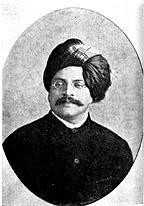
Vishnu Digambar Paluskar (1872–1931) founded Gandharva school in 1901.
-
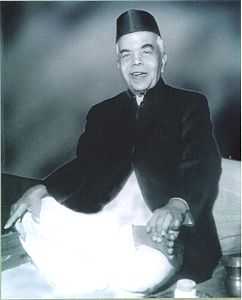
Gururao Deshpande - (1889–1982)
-
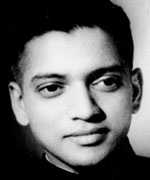
Dattatreya Vishnu Paluskar (1921-1955) was a child prodigy from Nasik.
- Krishnarao Shankar Pandit[2]
- Raja Bhaiya Poonchwale[3]
- Balakrishnabuwa Ichalkaranjikar (1849–1926, brought Gwalior gharana style to Maharashtra)
- Vishnu Digambar Paluskar - (1872–1931, disciple of Balakrishnabuwa Ichalkaranjikar, founded Gandharva Mahavidyalaya)
- Anant Manohar Joshi - (1881 - Unknown), disciple of Balakrishnabuwa Ichalkaranjikar and Sangeet Natak Akademi Awardee in 1955.
- Gururao Deshpande - (1889–1982)
- Vinayakrao Patwardhan - (1898-1975, Padma bhushan awardee in 1972)
- D. V. Paluskar - (1921-1955, child prodigy from Nasik, disciple of Vinayakrao Patwardhan)
- Ustad Rafique Khan
- Ustad Mian Bannay Khan Sahab
- Ustad Meeran Baksh Khan aka Ustad Amir Khan
- Ustad Gaaman Khan
- Ustad Pyare Khan
- Ustad Sendhay khan
- Ustad Mubarak Ali Khan
- Ustad Sendho Khan
- Ustad Beebay Khan
- Ustad Murad Ali Khan
- Ustad Ashiq Hussain Khan
- Ustad Qudratullah Khan
- Ustad Umeed Ali Khan
- Ustad Manzoor Ali Khan
- Ustad Ghulam Rasool Khan
- Ustad Ahmed Ali Khan
- Ustad Rehmat Ali Khan
- Ustad Hameed Ali Khan
- Ustad Fateh Ali Khan
- Ustad Waheed Ali Khan
- Karam Abbas Khan
- Roshan Abbas Khan
- Iqrar Waheed Ali Khan
- Tausif Ali Khan
- Latif Ali Khan
- Pandit Madhup Mudgal
- Pandit Vinaychandra Maudgalya
Contemporary artists
-
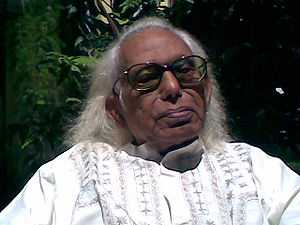
Ustad Abdul Rashid Khan is the oldest exponent of the Gwalior gharana at 106 years.
-

Malini Rajurkar performing at Argya 2011
-
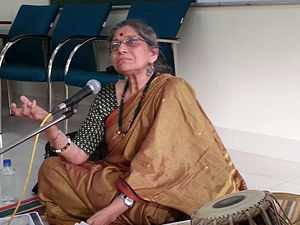
Neela Bhagwat is known composing & performing thumris from a feminist perspective.
- Abdul Rashid Khan - oldest exponent of the gharana, disciple of Chhote Yusuf Khan. Bharat bhushan (2013)[4] and Sangeet Natak Akademi (2009) awardee.
- Malini Rajurkar - disciple of Vasantrao Rajurkar, acknowledged master of Tappa and Tarana, Sangeet Natak Academy Awardee (2001).
- Pandit Vinayak Torvi - disciple of Pandit Gururao Deshpande, also influenced by Kirana, Agra and Jaipur gharanas.
- Veena Sahasrabuddhe - also influenced by Jaipur and Kirana gharanas.
- Ghulam Hassan Shaggan - renowned khayal singer, disciple of Ustad Bhai Lal Muhammad, Sitara-e-Imtiaz awardee in 2000 from Govt. of Pakistan.
- Neela Bhagwat
- Meeta Pandit
- Shashwati Mandal Paul ([5])
- Manjusha Kulkarni-Patil
- Arman Khan (1988–present) - After Sadarang son of Niyamat Khan belongs to the family of Tansen's daughter, is musical composer & one of the finest lyricist of Gwalior Gharana.
- Ustad ShahJahan Khan - (1990–present), versatile singer/artist and brother of Arman Khan, did research work on Eastern, Western, Classical & Modern Singing styles. He introduced & brought Qawwali singing, for the very first time in this Gharana.
- Ashok Huggannanavara
- Muslim Hassan Shaggan - grandson and disciple of Ghulam Hassan Shaggan.
References
- ↑ Mukherji, Kumar Prasad (2006). The Lost World of Hindustani Music (2006 ed.). Delhi: Penguin Books. p. 57. ISBN 978-0-14-306199-1.
- ↑ "Krishnarao Shankar Pandit". ITC Sangeet Research Academy. Retrieved 19 October 2014.
- ↑ Kumr, Ranee (March 29, 2013). "Music from the ‘school’". Retrieved 19 October 2014.
- ↑ "Padma Awards 2013: Full list". Zee News. January 25, 2013. Retrieved 10 October 2014.
- ↑ Sarvamangala, C.S (5 October 2012). "The eternal note". The Hindu. Retrieved 7 October 2014.